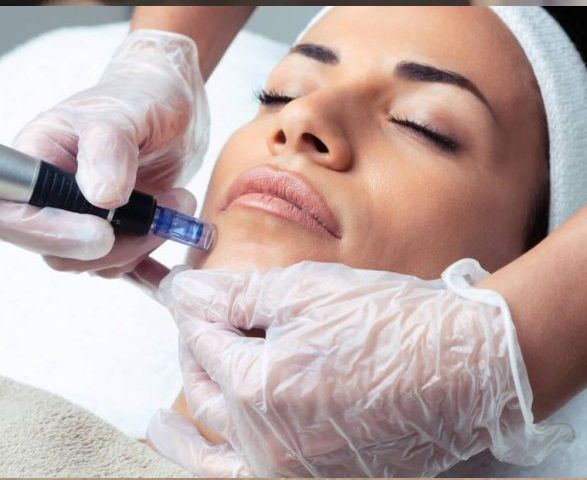
Microneedling is an invasive cosmetic procedure used to treat skin concerns via collagen production. It involves pricking the skin with tiny sterilized needles. The small wounds cause your body to make more collagen and elastin, which heal your skin and help you look younger.
Microneedling may help with issues like:
- Acne
- Hair loss (also called alopecia)
- Dark spots or patches on your skin (hyperpigmentation)
- Large pores
- Reduced skin elasticity
- Scars
- Stretch marks
- Sun damage
- Fine lines and wrinkles.
Microneedling is less expensive than laser treatments, which can cost about four times as much!
One session $220
Package of 3 sessions (2-3 weeks between sessions) $540
About Microneedling
Microneedling, also known as collagen induction therapy, is a minimally invasive cosmetic procedure designed to improve the appearance of the skin by stimulating the body’s natural healing processes. This treatment involves using fine needles to create tiny punctures in the top layer of the skin, which triggers the production of new collagen and elastin. Here’s an in-depth look at microneedling:
How Microneedling Works
Microneedling involves using a device equipped with fine, sterile needles to create controlled micro-injuries to the skin’s surface. These micro-injuries stimulate the body’s natural wound-healing process, which involves:
- Inflammation: The initial injury triggers an inflammatory response, which includes increased blood flow and the activation of various growth factors.
- Proliferation: New tissue forms as collagen and elastin production is stimulated. New blood vessels develop, improving blood flow to the area.
- Remodeling: The newly formed tissue matures and strengthens, resulting in improved skin texture, tone, and firmness.
Benefits of Microneedling
- Improved Skin Texture and Tone: Reduces the appearance of fine lines, wrinkles, and rough skin texture.
- Scar Reduction: Effective in reducing the appearance of acne scars, surgical scars, and stretch marks.
- Pore Size Reduction: Helps minimize the appearance of large pores.
- Hyperpigmentation and Sun Damage: Can improve uneven skin tone and reduce the appearance of dark spots and sun damage.
- Enhanced Product Absorption: Increases the absorption and effectiveness of topical skincare products.
The Microneedling Procedure
Consultation:
- Assessment: The skincare professional will assess your skin condition, discuss your goals, and determine if microneedling is appropriate for you.
- Customization: A personalized treatment plan is developed based on your specific needs and skin concerns.
Preparation:
- Cleansing: The skin is thoroughly cleansed to remove any makeup, oils, and impurities.
- Numbing: A topical anesthetic is applied to the skin to minimize discomfort during the procedure.
Microneedling:
- Device: A microneedling pen or roller is used to create tiny punctures in the skin. The depth and intensity can be adjusted based on the treatment area and desired results.
- Technique: The device is moved across the skin in a systematic manner to ensure even coverage and consistent results.
Post-Treatment Care:
- Soothing Products: A soothing serum or mask may be applied to calm the skin and promote healing.
- Aftercare Instructions: Patients are typically advised to avoid sun exposure, vigorous exercise, and certain skincare products for a few days after the procedure.
Recovery and Results
- Downtime: Minimal downtime is associated with microneedling. Patients may experience redness, mild swelling, and slight discomfort for a day or two post-treatment.
- Healing: The skin begins to heal immediately, with noticeable improvements in skin texture and tone visible within a week. Full results develop over several weeks as collagen production continues.
- Multiple Sessions: For optimal results, multiple sessions are often recommended, typically spaced 4-6 weeks apart.
Risks and Side Effects
- Temporary Redness and Swelling: Common immediately after the procedure but usually subsides within a few days.
- Minor Bleeding and Bruising: Possible, especially with deeper treatments.
- Infection: Rare, but can occur if the procedure is not performed under sterile conditions.
- Hyperpigmentation: In rare cases, individuals with darker skin tones may experience temporary darkening of the treated area.
Choosing a Provider
- Qualifications: Ensure the procedure is performed by a licensed and experienced skincare professional or dermatologist.
- Reputation: Look for a reputable clinic with positive reviews and a track record of successful treatments.
- Consultation: A thorough consultation should be provided to discuss your goals, skin concerns, and any potential risks.
Conclusion
Microneedling is a versatile and effective treatment for improving various skin concerns, from fine lines and wrinkles to scars and hyperpigmentation. By stimulating the body’s natural healing processes, microneedling can enhance skin texture, tone, and overall appearance. Consulting with a qualified professional can help determine if microneedling is the right treatment for your skin care needs and goals.



